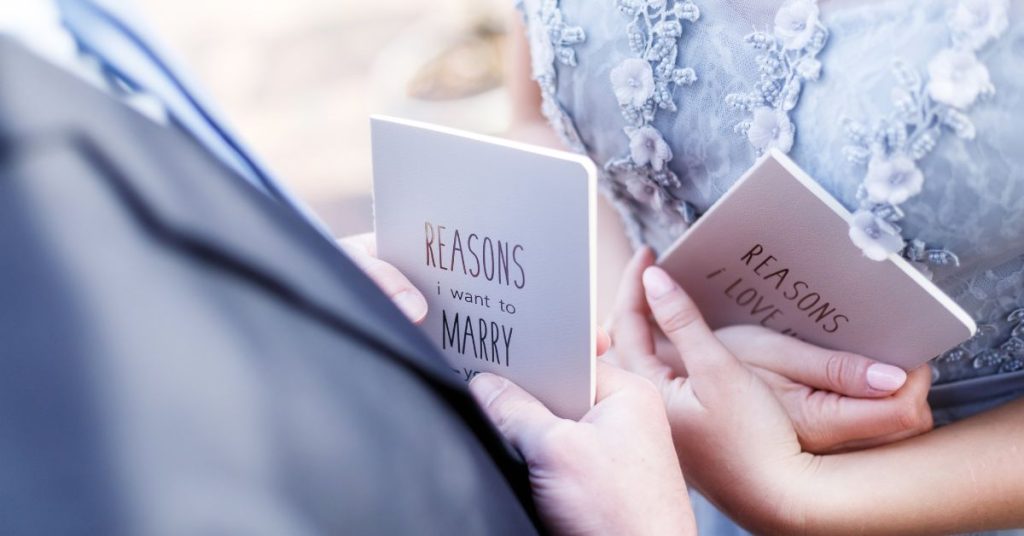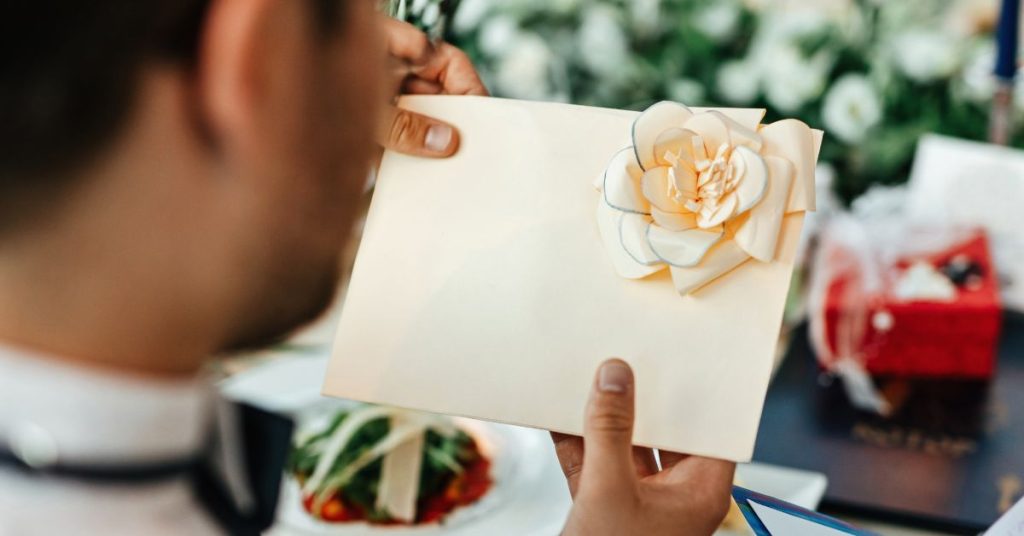Writing vows together can be an intimate experience that allows a couple to truly delve into what makes their relationship unique, while also planning the heartfelt words they’ll share on their big day. However, it’s a process that can be both exciting and daunting, especially when trying to encapsulate a whirlwind of emotions into a few precious sentences. In this comprehensive guide, we will explore tips on writing vows together, offering insights into everything from finding inspiration and incorporating traditions to legal considerations and involving family. Whether you’re a couple looking to pen your own vows or simply curious about the process, join us as we journey through the art of crafting the perfect commitment.

Starting early
Avoid rushing: Avoid rushing the process of writing your vows, as this is a time where emotions, memories, and future commitments converge into words that symbolize your unique relationship. Starting early gives both partners ample time to reflect on what they truly want to say, without the pressure of looming deadlines. It allows for thoughtful contemplation, discussion, and even revisions, ensuring that the vows are a genuine reflection of the love and understanding shared. If written is haste, there’s a risk that these critical expressions of commitment may become clichéd or impersonal. Taking the time to carefully consider each word, phrase, and sentiment fosters a more authentic and resonant connection to the vows themselves.
Initial brainstorming: Initial brainstorming is an essential stage in crafting your wedding vows, laying the foundation for what will become a deeply personal expression of your relationship. This phase isn’t about creating perfect sentences or polished phrases; it’s about gathering raw thoughts, feelings, memories, and promises that encapsulate what your union means to both of you. It might include reminiscing about significant milestones, identifying the core values that bind you together, or articulating dreams and hopes for the future. Some couples find it helpful to write individually at first, jotting down whatever comes to mind, and then coming together to share and explore these initial ideas. Others may prefer a collaborative approach from the outset, engaging in open dialogue and mutual discovery.
Finding inspiration
Read examples: Reading examples from various sources can serve as a wonderful starting point. Whether it’s classic wedding vows from different cultures, lines from your favorite poetry, meaningful quotes, or even lyrics from songs that resonate with your love story, these examples can spark ideas and help you identify the tone, language, and sentiments that feel true to your relationship. Some couples might find solace in the time-honored words that have united lovers for generations, while others might draw inspiration from unconventional sources that echo their unique bond. By exploring these examples, you are not simply borrowing someone else’s words, but engaging in a reflective process that helps you distill what you genuinely want to express. It’s a way to see how others have articulated love and commitment, offering a diverse perspective that can inspire your own creativity.
Reflect on your relationship: Reflecting on your relationship is perhaps one of the most vital and intimate aspects of writing your vows, as it invites both of you to delve into the very core of what has shaped your love and commitment. This isn’t just a mere stroll down memory lane; it’s an explorative journey through the trials, triumphs, joys, and growth that have defined your time together. Think about the first meeting, the shared experiences that brought you closer, the challenges that tested your bond, and the dreams you have nurtured together. Consider the everyday moments that capture the essence of your love, whether it’s a shared joke, a comforting gesture, or a particular way you support each other.
Structure and length
Keep it balanced: Keeping your vows balanced is a subtle yet essential aspect of crafting words that truly reflect the mutual respect and equality in your relationship. Balance in this context doesn’t necessarily mean identical wording or matching lengths, but rather a harmonious interplay of emotions, promises, and sentiments that resonate with both partners. It’s about ensuring that the vows reflect the individuality of each person while also mirroring the shared values and commitments that unify you as a couple. A well-balanced vow acknowledges both the uniqueness and the togetherness of your bond, embracing differences while celebrating commonalities. Consider discussing the tone, themes, and even the practical aspects like length, to ensure that both sets of vows feel cohesive and complementary. While it’s perfectly fine for one partner to be more poetic and the other more straightforward, there should be a shared essence that threads the vows together.
Stay concise: Staying concise in your wedding vows might seem counterintuitive, given the profound significance and emotion behind the words. However, conciseness isn’t about minimizing love or skimping on sentiment; it’s about focusing on what truly matters and expressing it in a clear and heartfelt manner. When writing vows, it’s easy to become overwhelmed with all the things you want to say and promise, but brevity can often bring more power and resonance. By choosing your words carefully and focusing on key sentiments and promises, you can convey the essence of your love without diluting it with excessive detail or repetition. This doesn’t mean you need to reduce your vows to mere bullet points, but rather find a balance where each word and phrase carries weight and meaning. Staying concise allows your vows to flow smoothly and maintain the attention and engagement of your partner and those witnessing your commitment. Working together to keep vows concise can also be a bonding experience, as you both navigate what truly defines your relationship and your future together.
Incorporating traditional element
Mix of old and new: Blending the old with the new in your wedding vows is a thoughtful way to honor traditions while infusing your unique personality and contemporary values into your commitment. Whether it’s weaving in lines from classical literature or religious texts, or integrating cherished family sayings with modern promises tailored to your shared life, the mix of old and new creates a rich tapestry that feels both timeless and relevant. It’s an acknowledgement that love, in its essence, is eternal, yet it’s also ever-evolving, shaped by individual experiences and the world in which you live. By consciously choosing what elements of the past to bring into your vows, and how to align them with your present beliefs and future aspirations, you create something deeply personal and resonant. This process often involves dialogue and collaboration between partners, exploring what traditions mean to you both, and how to adapt them in a way that feels authentic.
Incorporating religious elements
Consulting with officiants: Consulting with the officiants who will be leading your wedding ceremony is an often overlooked yet vital part of crafting your vows. The officiant, be it a religious leader, a legal representative, or a celebrant, can provide essential guidance on both the legal and ceremonial aspects of your vows. They can help you navigate any cultural or religious nuances that may need to be addressed, offering advice on wording or content that will resonate with your chosen ceremony style. Their insight into what works well in practice can also assist you in shaping vows that are not only meaningful to you but will be clearly understood and appreciated by your guests. Moreover, their understanding of the legal framework in your jurisdiction can help ensure that your vows meet any necessary legal criteria.
Maintaining surprise
While many couples choose to craft their vows together, working on the details and even sharing drafts, others opt to keep their final words a secret until the moment they are spoken. This choice depends on personal preference, and there’s no right or wrong way, but the decision to maintain surprise can create a magical intimacy during the vows, allowing both partners to hear these heartfelt promises for the first time in the presence of loved ones.
The unveiling of the vows becomes a shared gift, a moment of revelation that captures the essence of love, commitment, and vulnerability. It adds an extra dimension to the ceremony, a spontaneous reaction and a genuine connection that is not only shared between the couple but witnessed by those in attendance. Maintaining surprise in your vows is not just about creating a dramatic moment; it’s a choice that can deepen the emotional impact of your words, allowing them to resonate in an immediate and powerful way, imbued with the authenticity and spontaneity of love’s unpredictable nature.
Dealing with nerves
It’s natural to be nervous: Feeling nervous about writing or reciting your wedding vows is an entirely natural response, one that many couples experience as they approach this significant moment in their lives. Embracing the nerves as part of the journey allows you to channel them into a focused and heartfelt expression of love. Remember, the vows are not a performance but a personal and authentic declaration of love, so perfection is less important than sincerity. Your partner and those present are there to celebrate your love, not critique your words.
Recognizing that nervousness is a common and natural aspect of this process can bring comfort and perspective, reminding you that the power of your vows lies not in their eloquence but in the genuine love and commitment they represent. It’s not about erasing the nerves but embracing them as part of the beautiful complexity of declaring your love and dedicating your life to another person.
Digital considerations
Online ceremonies: Online ceremonies have become an increasingly prevalent option for couples, especially in times when physical gatherings may be limited or challenging. These virtual ceremonies present unique opportunities and considerations for crafting and delivering your wedding vows. Consider the clarity of sound and video, making sure that everyone involved can hear and see the vows being exchanged. Practicing beforehand with the chosen platform and even conducting a rehearsal with the officiant can alleviate technical concerns.

Additionally, the nature of an online ceremony may allow for creative elements, such as incorporating multimedia or involving distant friends and family in unique ways. It’s also essential to recognize that an online setting might alter the dynamics of the moment, requiring perhaps more deliberate pacing, clear articulation, and visual cues to convey what might naturally be communicated in person.





